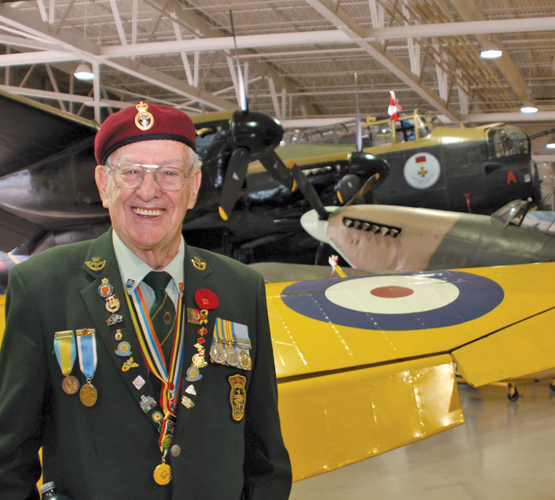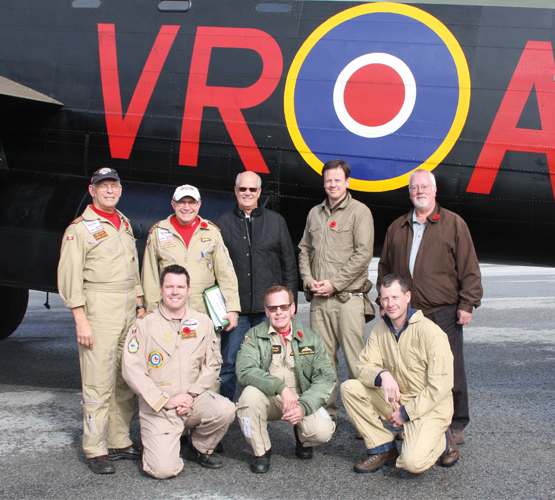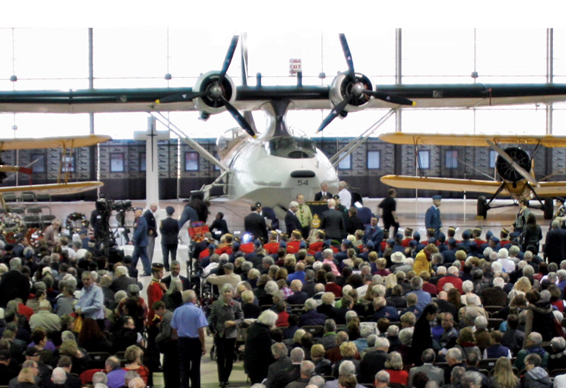
Korean War veteran Ed Heatley was among more than 2,500 attending the Remembrance Day ceremony at the Canadian Warplane Heritage Museum in Hamilton, Ont. [Sharon Adams]
Hamiltonians gathered
to honour veterans of all
stripes and many conflicts
The silence during the Remembrance Day ceremony at the Canadian Warplane Heritage Museum in Hamilton, Ont., was just ending when a distant thrum could be heard, a noise that grew and swelled and multiplied until the magnificent sound of an Avro Lancaster bomber’s engines filled the hangar, rattled the windows and drowned out the plaintive voice of the pipes. Then it quickly faded.
The crowd of more than 2,500 had just experienced some of the thunder of the Second World War, and could be forgiven for imagining the sonic fury of hundreds of aircraft streaming overhead, leaving England for their deadly business on the Continent.
The museum’s Lancaster bomber, coded VR-A and affectionately known as VeRA, “slipped the surly bonds of Earth” to fly over a handful of ceremonies in the Hamilton area. Passengers Cameron Plewes, Dean Potter and David French, friends and pilots from Calgary, and John Genereaux of London, Ont., were thrilled to be aboard this day, of all days.
VeRA is a mobile memorial to the 55,573, including 10,000 Canadians, killed in the service of Bomber Command during the Second World War. She is dedicated to Pilot Officer Andrew Mynarski of Winnipeg, posthumously awarded the Victoria Cross for coming to the aid of a crewmate trapped in the tail turret of a burning and plummeting Lancaster. Mynarski bailed out only after his flight suit and parachute had caught fire. The trapped bomb aimer survived, but Mynarski died of burns.
By the end of the war, Canadian No. 6 Group was operating 13 Lancaster squadrons. Thousands of Canadians worked to produce 430 Lancaster Mark Xs—including VeRA—at Victory Aircraft in Malton, Ont. Of the 7,377 Lancs produced, only 17 survive and only two are airworthy.
Most of the Lancasters ended up as scrap metal—which might have been VeRA’s fate but for the Goderich Branch of The Royal Canadian Legion, which acquired the plane for display. The museum obtained it in 1978, and it took a decade of volunteer labour to restore the craft to airworthiness. Unstinting attention by a team of volunteers keeps the aircraft in good shape for the summer flying season. VeRA’s throaty roar stops people in their tracks and draws Hamiltonians from their houses to watch her as she passes overhead.
Genereaux went up to honour the memory and service of his father Charles, a Second World War navigator. “He started in Wellingtons, went to Halifaxes, and in the last year, they got the Lancaster. He served the whole war; he did one tour, came back to Winnipeg teaching navigation, then went back for a second tour.”
Genereaux treasures the flight log of that second tour. His father belonged to a select group: 45 per cent of the 120,000 who served in Bomber Command perished. In 1942, Britain’s Air Ministry calculated that the chances of surviving two tours—60 operations—were just 19.5 per cent.
While the Lancaster, accompanied by the museum’s B-25 Mitchell bomber, was flying over other ceremonies, a Canso flying boat, dedicated to Flight Lieutenant David Hornell, served as the backdrop to the museum’s ceremony. After sinking a U-Boat, Hornell’s Canso was shot down and the crew took turns in the icy waters, awaiting rescue. Hornell died from exposure and was posthumously awarded the Victoria Cross.
“We chose that airplane,” said David Rohrer, president of the museum, “because the Canso, flown by the RCAF from 1939 right up to 1961, protected our coasts, did convoy escorts and U-boat hunting.”
The service drew veterans of all stripes and many conflicts, men and women to whom remembrance is a duty.
Veteran Bill Liggett also served in the North Atlantic. A steward aboard HMS Nabob, he survived a torpedo attack that blew a gigantic hole in the carrier.
“I was a steward, but when you’re in battle, you are at your battle station,” he said. “We were in the worst of it in the North Sea [near] Norway and Sweden. We were protecting merchant vessels, taking food and supplies to the Russians. We were on attack against the enemy all the time, and vice versa. With no hesitation, I’d say we did our best.”

Crew and passengers beside the museum’s Avro Lancaster bomber, fondly known as VeRA. The aircraft performed flypasts above Hamilton area ceremonies on Remembrance Day. [Sharon Adams]
Many, such as Bosnia and Afghanistan veteran David Timms of Brantford, Ont., were honouring the memory of colleagues whose lives were lost in service or in the aftermath. Timms, Bill Asselin and John Armstrong of the Gully Chapter of Canadian Army Veterans Motorcycle Units in Hamilton placed one of a score of wreaths, along with representatives of the RCAF and RAF, community groups and local politicians.
Bosnia veteran Sean Mehar of Stoney Creek, Ont., attended in remembrance of many comrades, as did veteran Corinne MacDonald, of Dundas, Ont., accompanied by her grandson Alastair. She served as a truck driver with the air force in Vancouver during the war.
Veteran Ed Heatley, who served with the Princess Patricia’s Canadian Light Infantry, was remembering buddy Dan Jackson, who died in Korea.
The guest speaker was retired general Tom Lawson. When he asked veterans to identify themselves, thunderous applause—near to the noise made by the Lancaster overhead—filled the museum hangar in a tribute to Second World War veterans.
Lawson recalled the final lines of “In Flanders Fields”—John McCrae’s poem—“which pose a challenge to us, a challenge to the generations to remember what happened and keep faith with those who fell,” said Lawson. “If he were here today, a century later, and saw where we are as a nation, he would know we listened and heard his challenge. He would have cause for deep pride.”
The museum’s Remembrance Day tribute ended at a movie theatre for the premier of Reunion of the Giants, a documentary about VeRA’s 2014 tour to the United Kingdom, where she met up with the RAF Lancaster, the first time in nearly half a century that Lancasters were flown in formation. Cineplex sponsored free showings of the documentary at a score of theatres across the country on Remembrance Day.
Advertisement






















